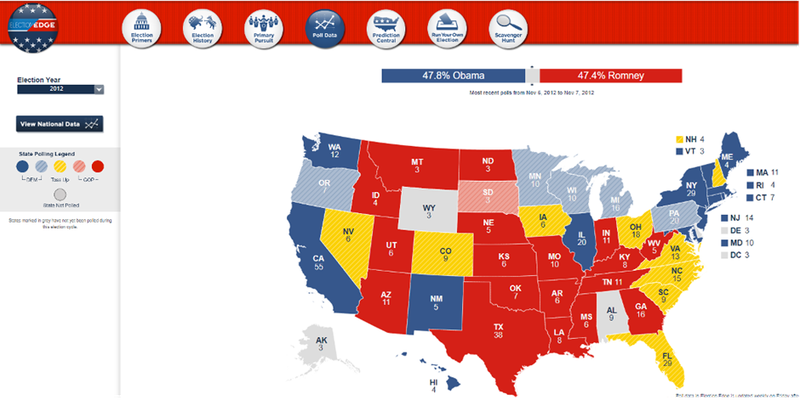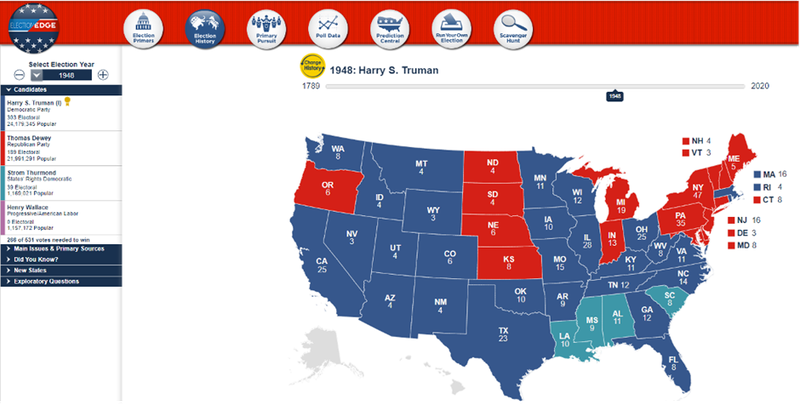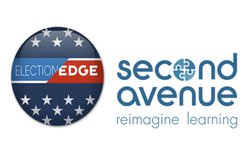Election Edge is an award winning, non-partisan platform for teachers to explore U.S. History and the Presidential election process with students. Teachers have access to standards-aligned guides, lesson plans, and worksheets to educate students about U.S. history and the evolving political landscape. Election Edge includes access to primary results and polling data that provides students opportunities to analyze visual data, think critically and make predictions. The depth of credible information and analysis within Election Edge is unrivalled in civics education. Election Edge is applicable as a core or supplemental curriculum for teaching content in U.S. History, APUSH, AP Government or civics education courses.
Formats/platforms used:
Election Edge integrates with Canvas, Google Classroom, Schoology and LTI Standards
Primary website’s URL:
https://secondavenuelearning.com/election-edge/

Problem solved:
Election Edge was developed by Second Avenue Learning, a trusted developer of educational technology for learning and serious games for over 18 years, with award-winning products like Election Edge, Martha Madison and Voices for Suffrage. Election Edge’s content is intentionally designed for non-partisan discussion, and the presented information is directly informed by credible research citations. As a supplemental resource for civics education, Election Edge’s capabilities have many cross-curricular applications in the social studies classroom, like facilitating student-led discourse and data-driven analysis of past and present presidential elections.
Grades/age range
Election Edge’s comprehensive, non-partisan toolkit supports students in grades 5-12 in talking, thinking about and understanding the electoral process and their role within the political landscape.
Does the product address core/supplemental/special needs/extracurricular/professional development?
Election Edge is a supplemental curriculum with grade-level and standards-aligned guides, lesson plans, and worksheets that educate students about U.S. history and the evolving political landscape. As a U.S. History and civics platform, it can be used alongside existing curricula both during and outside an election year. In addition, cross-curricular math connections are made when reading and understanding how polls are relevant, and interpreting that data becomes a critical skill.
Standards:
Election Edge provides educators with a dependable civics and social studies curriculum that is factual, high-quality, and standards-aligned, including Correlations to the Common Core, NCSS standards, FERPA, COPPA, NYS Ed Law 2-D, and WCAG 2.1 compliant.

Lesson time needed:
Election Edge is a flexible resource to leverage to support and enhance educators’ current practice throughout the year. Quick bell ringers or exit tickets can easily be created based on weekly polling updates. Teachers can facilitate an in-depth analysis of historic elections. Election Edge can complement regular lesson plans or be used as a full unit of study. The interactive functionality gives teachers the ability to identify an assignment using the existing curriculum located in the resources and lesson plans. Teachers who want to prepare their own lesson can create an assignment using the most powerful election results tool in an un-biased way to give them the opportunity to have constructive discourse in their classroom. Those interested in learning more about civics education can spend time navigating data and cited sources endlessly!
Pricing model:
Tiered by the total number of students.
Additional services:
There is an optional professional development component, either a 2-hour self-paced web training session or half day of in-person training.
What makes Election Edge unique?
The inspiration for Election Edge was driven by the shortage of civic understanding and historical context present among students and adults alike. It gives teachers a tool to help students unpack key elements of U.S. History and the election process. Election Edge offers resources with cited sources to teach historic moments in U.S. elections, state by state data, and build skills for civil discourse. Ahead of U.S. presidential election years in particular, Election Edge can help students understand and have the capacity to be informed citizens.
Characteristics:
(UI) Election Edge transforms passive observers into active participants through its interactive features. From interactive maps that visualize electoral districts to a clean interface that organizes information logically, those unfamiliar with civics education can navigate with ease. Real-time updates and personalized dashboards keep users informed and invested in the electoral process, whether hosting their own or navigating a public election, fostering a sense of civic duty.
(UX) Designed and written jointly with teachers, faculty, subject matter experts and end users, Election Edge invites simulation play in which students can cast predictions for electoral college votes, run elections, and conduct scavenger hunts. This enables teachers to use it confidently to promote a better understanding of historical moments and trend lines over time.
Here's what users are saying:
“Election Edge has played a significant role in my students’ development and understanding of citizenship. When teaching civics, I want students to realize that they have a voice… and my hope is that they learn to use it well.”
--4th Grade Teacher, Woodrow Wilson Elementary School
“My students are very conscious of current events and want to be informed about what’s going on in our government. Election Edge has helped them achieve those goals.”
--Teacher, Pittsford Mendon High School











